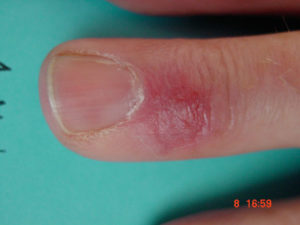Ganglion cysts are very common lumps within the hand and wrist that occur adjacent to joints or tendons.
The most common locations are the top of the wrist, the palm side of the wrist, the base of the finger on the palm side, and the top of the end joint of the finger. The ganglion cyst often resembles a water balloon on a stalk, and is filled with clear fluid or gel. The cause of these cysts is unknown although they may form in the presence of joint or tendon irritation or mechanical changes. They occur in patients of all ages.
These cysts may change in size or even disappear completely, and they may or may not be painful. These cysts are not cancerous and will not spread to other areas.
Diagnosis
The diagnosis is usually based on the location of the lump and its appearance. They are usually oval or round and may be soft or very firm. Cysts at the base of the finger on the palm side are typically very firm, pea sized nodules that are tender to applied pressure, such as when gripping. Light will often pass through these lumps, (trans-illumination) and this can assist in the diagnosis. Your physician may request x-rays in order to investigate problems in adjacent joints. Cysts at the end joint of the finger frequently have an arthritic bone spur associated with themé.

Treatment
Treatment can often be non-surgical. In many cases, these cysts can simply be observed, especially if they are painless, as they frequently disappear spontaneously. If the cyst becomes painful, limits activity, or is otherwise unacceptable, several treatment options are available. The use of splints and anti-inflammatory medication can be prescribed in order to decrease pain associated with activities. An aspiration can be performed to remove the fluid from the cyst and decompress it. This requires placing a needle into the cyst, which can be performed in most office settings. Aspiration is a very simple procedure, but recurrence of the cyst is common. If non-surgical options fail to provide relief or if the cyst recurs, surgical alternatives are available. Surgery involves removing the cyst along with a portion of the joint capsule or tendon sheath.
In the case of wrist ganglion cysts, both traditional open and arthroscopic techniques usually yield good results. Surgical treatment is generally successful although cysts may recur. Your surgeon will discuss the best treatment options for you.
Complications
No surgical intervention guarantees that there will not be secondary complications. Every decision which involves intervention should be aware of the risks that the surgeon has to inform you about.
Common complications related to hand surgery
- Nosocomial infections: they are rare and easily controlled with early diagnosis. Antibiotics and a new intervention may be necessary.
- Hematoma: the diagnosis must be early and surgical revision may also be necessary
- Sudeck syndrome (algodystrophy): this is a “disruptive” pain when there is no underlying problem. Its manifestation is independent of the type of surgery and can occur even after a simple immobilization. The hand becomes swollen, painful, and gradually stiffens. The evolution can be very long. Sequelae are possible (residual pain, the stiffness of the fingers and/or wrist, sometimes of the shoulder). Treatment is difficult and uses specific rehabilitation techniques
- Anaesthesia accident: the easiest but the most serious, including death (1 death per 100,000 to 150,000 anaesthesia).
Complications specific to ganglion cysts
- Recurrence: the most common complication in about 5% of cases. It only leads to reoperation if the discomfort is significant. This reoperation does not completely exclude the risk of further recurrence.
- Failure to heal (Rare).
- Stiffness of the joint. More the fact of underlying osteoarthritis than operation.
- Pain on the scar (frequent). The region rarely remains sensitive, with sensations of burn for several weeks or even months.
© 2006 American Society for Surgery of the Hand



 Français
Français English
English